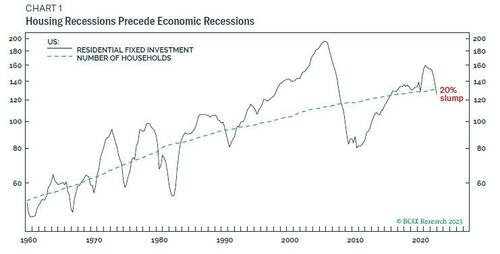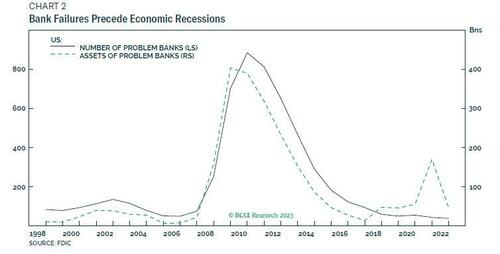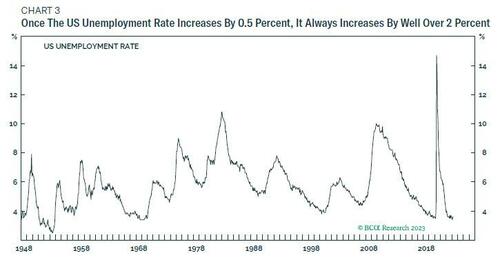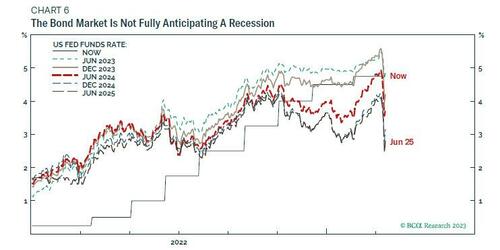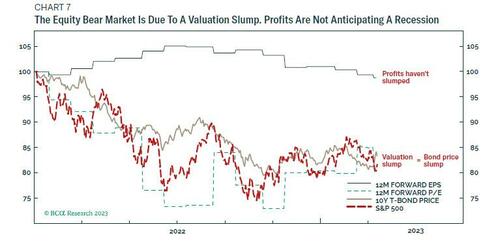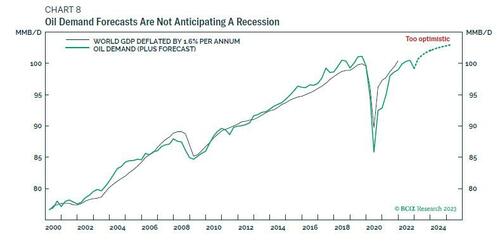

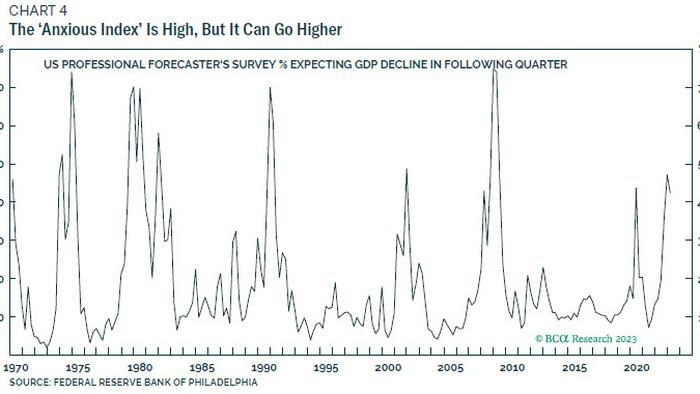
By Dhaval Joshi, chief strategist at BCA Research
Exactly one year ago today, the US Federal Reserve embarked on the most aggressive tightening cycle in modern history. It comes as no surprise then that the US has just passed two of the three staging posts to recession.
The first staging post is a housing recession. US residential fixed investment (home building) has slumped by a fifth. This is significant because post-1970 housing recessions have predicted economic recessions with a perfect four out of four success rate: 1974; 1980; 1990; and 2007 (Chart 1).
The second staging post is bank failures. Banks tend to fail just before recessions begin. Ahead of the recession that began in December 2007, no US bank failed in 2005 or 2006. The first three bank failures happened in February, September, and October of 2007, just before the recession onset.
Fast forward, and no US bank failed in 2021 or 2022. The first bank failures of this cycle – Silicon Valley Bank and Signature Bank – have just happened. If history is any guide, the start of bank failures presages an economic recession that is more imminent than many people anticipate (Chart 2).
To be clear, it is not the direct impact of the housing recession or the bank failures that causes the economic recession. The housing recession and bank failures are simply the early warning signs – the ‘canaries in the coal mine’ – that tell us that high interest rates are killing the economy.
The US Economy Has Passed Two Staging Posts To Recession. Here’s The Third
Many economists argue that once a recession is staring you in the face, you can promptly cut interest rates to stop it in its
tracks. Good luck with that. This is like arguing that once the iceberg was staring you in the face, you could promptly reverse the engines to save the Titanic.
Interest rates work with a lag. The impact of tightening takes time to be felt. To repeat, the first US rate hike happened exactly a year ago today, but we are seeing the first bank failures now.
In a downturn, the ‘corrective’ impact of loosening also takes time to be felt. Conversely, the ‘self-reinforcing’ feedback that accelerates the downturn – like a bank run, or households increasing their precautionary saving in response to higher unemployment – is immediate.
This makes a recession a non-linear system. Once you’ve passed the point of no return, it is too late to reverse the engines. You cannot avoid the iceberg. In the case of the US economy, once the unemployment rate has increased by 0.5 percent, it has always gone on to increase by well over 2 percent (Chart 3).
So, the third and final staging post to recession is the US unemployment rate increasing by 0.5 percent. So far, it is up by 0.2 percent.
How The ‘Most Anticipated Recession Ever’ Is Still Unanticipated
Is the coming recession the most anticipated ever? The Philly Fed’s latest so-called ‘anxious index’, showed that the proportion of economists expecting the US economy to contract in the second, third, and fourth quarters of 2023 stood at 42 percent, 45 percent, and 41 percent respectively. These are among the most pessimistic readings for any time that a recession hasn’t already begun (Chart 4).
Still, the proportion of economists predicting a recession is a minority. This is confirmed by the survey’s overall forecast for US GDP that shows no decline through the next four quarters – though admittedly, that was in mid-February before the recent bank failures (Chart 5).
The absence of a forecasted recession might reflect the bias of economists to sugar-coat their predictions, given their asymmetric incentive structure. For an economist’s standing, the best thing is to be right. But if you are wrong, it is better to miss a recession, than to forecast a recession that does not happen. On this basis, peak pessimism should never increase above the high 40s. Yet it does.
Once a recession begins, it is no longer taboo to forecast a contraction in the economy. As the sugar-coating of economists’ forecasts ends, the anxious index can surge to above 70 percent, and forecasts for the economy can collapse. In this important regard, the most anticipated recession is still very unanticipated.
Interest Rates, Profits, And Crude Oil Are Not Fully Anticipating A Recession
In the financial markets, the deeply inverted US yield curve means that the bond market is forecasting aggressive rate cuts – around 200 basis points through the next two years. As the Fed only cuts aggressively in a recession, the bond market is anticipating a recession.
That said, the forecasted pace of cutting, at 25 basis points per quarter, is too low – given that in previous recessions the pace of cutting has been 80-150 basis points per quarter. Meaning, the bond market is not fully anticipating a recession (Chart 6).
Our February 8th recommendation to buy the December 2024 Fed funds future FFZ24 is panning out very well. The position is in huge profit and a big part of the expected gains have been made. Traders may wish to crystallize those gains, but the rally will end only when the rates curve fully anticipates a recession. Meanwhile, long bonds (10-year and longer maturity) have at least 10 percent price upside.
What about the stock market? Many people argue that the bear market since early 2022 indicates that the stock market is anticipating a recession. This is wrong. The slump in stocks is mostly due to a slump in valuations, caused by the bear market in bonds. Profit forecasts have not slumped (Chart 7).
Based on previous recessions, these profit forecasts are vulnerable to at least a 20 percent downgrade. Mitigating this somewhat, an uplift to bond valuations will boost stock valuations, and limit further downside in the stock market to around 10 percent.
Bonds have outperformed stocks in every recession of the past 75 years, including the recessions of the inflationary 1970s. But with bonds only now starting to outperform stocks, bonds versus stocks is not yet anticipating a recession.
Turning to commodities, the oil market is not anticipating a recession either. Crude oil demand tracks world GDP, albeit deflated by 1.6 percent a year due to steady gains in energy efficiency. This means that the 2 percent annual growth forecast for world oil demand through 2023-24 would require world GDP to grow at a 3.6 percent clip through the next two years (Chart 8).
Yet even a “soft landing” in the US and Europe would cause growth in developed economies to slow to around 1 percent. Meanwhile, China’s outgoing Premier Li Keqiang recently announced China’s GDP target for 2023 at “about 5 percent." This makes the oil market’s implied forecast for demand growth far too rosy, and in a recession the destruction of oil demand always outweighs any cutbacks to supply.
Hence, as I explained in Why Oil Is Headed To $55, the crude oil price has a further 25 percent downside.
To summarise for a 6-12 month investment horizon, bonds have a 10 percent upside, stocks have a 10 percent downside, and crude oil has a 25 percent downside.

